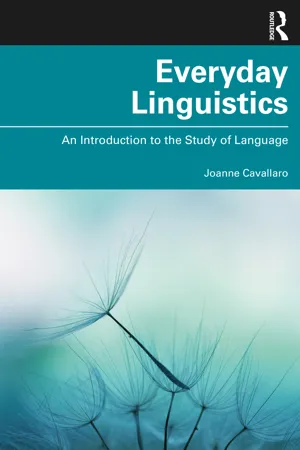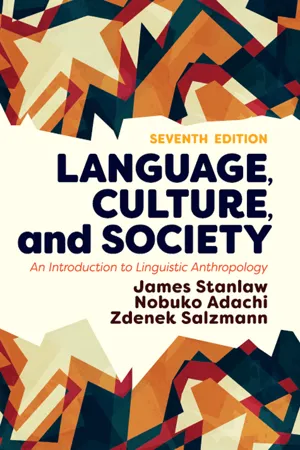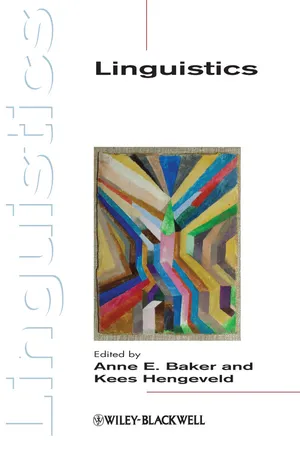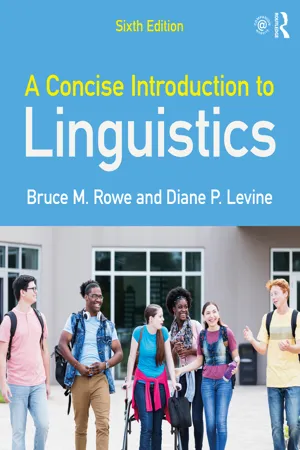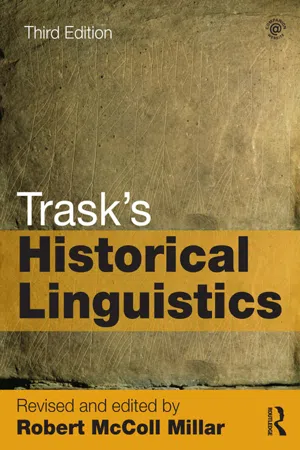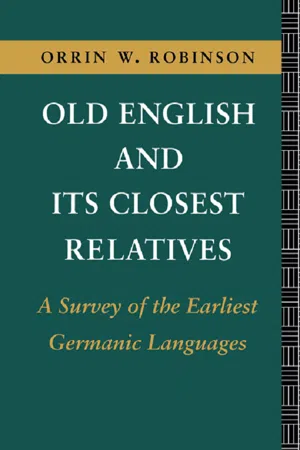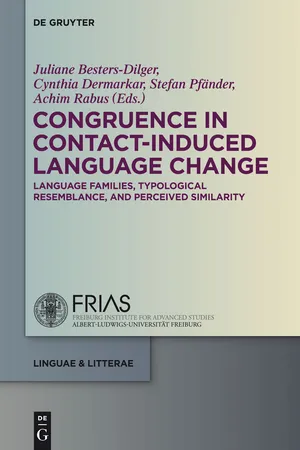Languages & Linguistics
Language Family
A language family is a group of languages that are historically related and share a common ancestor. These languages have evolved over time, resulting in similarities in vocabulary, grammar, and phonology. Linguists classify languages into families to better understand their development and relationships, which can provide insights into the history and migration patterns of different populations.
Written by Perlego with AI-assistance
Related key terms
Related key terms
1 of 4
Related key terms
1 of 3
9 Key excerpts on "Language Family"
- eBook - ePub
Everyday Linguistics
An Introduction to the Study of Language
- Joanne Cavallaro(Author)
- 2023(Publication Date)
- Routledge(Publisher)
proto-language is a hypothesized older language from which other languages have descended. Other linguists doubt this theory, believing that human language most likely has more than one origin. That debate and the ones about how language developed are likely to continue for some time, as there is little evidence to support a definitive answer. The time frame involved in trying to determine the origins of language, hundreds of thousands of years, means that we do not know much about any supposedly original language if one did exist.LANGUAGE SPREAD AND LANGUAGE FAMILIES
We may not know much about possible languages from 100,000 years ago, but we do know something about languages spoken 5,000 years ago and how they spread. We talk about languages spreading, but of course it’s not so much languages that spread as the people who speak them migrate and take them into new environments that may or may not have speakers of other languages there. As they spread, languages invariably change, partly as a result of natural language change and partly as a result of speakers adapting to new environments and interacting with speakers of other languages.Linguists place languages into various language families. Language Family here is used metaphorically to describe the relationship among certain languages: a parent language with daughter languages that have evolved from that parent language and that are, therefore, related. When linguists say that languages are related, often referred to as a genetic relationship, they mean that those languages share a common ancestor language. For example, French, Italian, Spanish, Portuguese, Romanian, Galician, Provencal, and Catalan, collectively known as Romance languages, are related in that they each evolved from Latin. Those relationships are fairly easy to trace as we have written records for hundreds, even thousands, of years. But what about when we have few or no written records, as is the case with languages spoken thousands of years ago? Can we reconstruct those familial relationships? Yes. In fact, linguists have done so for several language families.Indo-European Language Family
The idea of a common ancestral language for languages of Europe had long been conceived of, but the work of Sir William Jones in 1786 provided evidence for it. As a judge in India for the British, Jones studied Sanskrit, an ancient language of India, after already having learned Latin and Ancient Greek. In the course of his study, he noticed many similarities between Sanskrit and Latin and Ancient Greek. Jones posited a common source for them and for many other languages of Europe, India, and parts of the Middle East. His theory sparked further scholarship, with the eventual conclusion by scholars that most of the languages of Europe, as well as several in Iran, Afghanistan, and India, are related, all part of the Indo-European Language Family, having descended from a common language, what we now call Proto-Indo-European - eBook - ePub
Language, Culture, and Society
An Introduction to Linguistic Anthropology
- James Stanlaw, Nobuko Adachi, Zdenek Salzmann(Authors)
- 2018(Publication Date)
- Routledge(Publisher)
Anyone who knows Spanish will tell you that other languages, such as Portuguese or Italian, seem to be related to Spanish. This is due to their common origin from Latin. Traditionally, one of the most common activities in historical linguistics has been to classify languages according to these genetic relationships. It is difficult to give the exact number of languages spoken in the world at present, but the total undoubtedly approaches 6,000 (Krauss 1992:5–6), possibly 7,000. It is impossible to guess how many languages must have become extinct in prehistoric times. We do know that during the historical period for which we have written records, a great many languages have died out.Language FamiliesA language family includes all those languages that are related by virtue of having descended from a single ancestral language. The concept of the Language Family is somewhat conservative: it is generally employed only if the relationship and the correspondences among the languages have been firmly established by careful comparative work and a convincing number of cognates. Subdivisions of a Language Family are usually referred to as branches. The Indo-European Language Family (see Chart 8.1), for example, consists of almost a dozen branches (some of which have sub-branches; note: not all the languages and subfamilies are given in this simplified chart). Some branches are Germanic (with about a dozen languages, including German and English), Celtic (with four languages), Romance or Italic (with about a dozen languages, including French and Spanish), and Balto-Slavic (with more than a dozen languages belonging to either the Baltic or Slavic sub-branches—including Russian and Polish). Some branches are represented by a single language, for example, Albanian, Armenian, and Hellenic or Greek. Indo-Iranian, with its Indic and Iranian sub-branches, consists of several hundred languages and dialects spoken mostly in southwestern Asia. Some branches of Indo-European, for example, the Tocharian and Anatolian branches, are no longer represented by spoken languages.CHART 8.1 THE INDO-EUROPEAN Language FamilyThe number of languages that make up a Language Family varies greatly. The largest African family, Niger-Congo, is estimated to consist of about 1,000 languages and several times as many dialects. Yet some languages do not appear to be related to any other; these are referred to as language isolates - eBook - ePub
First Islanders
Prehistory and Human Migration in Island Southeast Asia
- Peter Bellwood(Author)
- 2017(Publication Date)
- Wiley-Blackwell(Publisher)
Almost all the indigenous peoples of Island Southeast Asia today thus speak languages within the Austronesian family, except in pockets of eastern Indonesia close to New Guinea where a few Papuan languages are spoken. Otherwise, all other spoken vernaculars in Island Southeast Asia arrived or developed in the colonial era. These include Taiwanese (a Sinitic language) in Taiwan, other Sinitic and Indic languages in Malaysia and Singapore, and English in Malaysia and the Philippines. Indonesia no longer needs a colonial language because of the wisdom of the government of independence and its advisors in choosing a trader language, Malay, rather than the Javanese language of the ruling class as the national lingua franca (Bahasa Indonesia) in 1945.What is a Language Family, and Why are Language Families Important?
Language families such as Austronesian are defined by lexical items and grammatical features that the constituent members have inherited directly from a period of common ancestry situated far back in time. Within each Language Family there will usually be a hierarchy of subgroups, with each larger subgroup incorporating two or more smaller ones. Each subgroup at any level will consist of a number of related languages deemed to relate more closely to each other than to any outsider language, and each subgroup will be defined by a series of innovations shared only by its members. “Sharing” in this sense depends, of course, on a demonstration through linguistic methodology that the item was inherited (cognate in linguistic terminology4 – for examples within Austronesian see Table 6.1 ), rather than borrowed from another language. Such subgroups develop as a Language Family radiates from an origin region and as the speakers of individual dialects move beyond the range of frequent communication and so develop linguistic innovations unique to themselves, their immediate neighbors, and their descendants, as related metaphorically in the opening quote for this chapter.Table 6.1 - eBook - ePub
- Anne E. Baker, Kees Hengeveld, Anne E. Baker, Kees Hengeveld(Authors)
- 2012(Publication Date)
- Wiley-Blackwell(Publisher)
The languages belonging to this family are, with the exception of Hungarian, spoken in parts of Northern Europe and Siberia. This family has two sub-families, one of which – the Uralic languages – is subdivided again. The names of the languages are printed in normal case, those of the (sub-)families in italics. Some of the languages, such as Chuvantsy, are no longer spoken. The Sami languages (North Finnish) are also called ‘Lappish’. This discussion of language families and the genetic relations between languages naturally leads to the question of the origin of language. Was there perhaps in the beginning one Proto-World language? If so, this would have to be placed at the very top of the pedigree of all the languages of the world. More than this we cannot say with any degree of certainty. Some researchers think that the predecessor of our own species of homo sapiens, the homo erectus who lived about two million years ago, had an elaborate and complex system for communication, perhaps some form of signing. From paleo-anatomical research it is plausible that the latest common ancestor of Neanderthals and homo sapiens, who lived about 400,000 years ago, was using some form of speech. 17.4 LANGUAGE AND CULTURE Differences between languages can be related to differences between cultures. But before we discuss this in further detail, we must first define the notion of culture. Culture, as we will use the notion here, consists of what is usually called ‘high culture’: literature, music, painting, etc., but also the much wider domain of values, norms and customs of a society. This includes views on what is right and wrong, ideas about the education of children, and, wider still, the domain of ‘material culture’, that is, everything around us, both nature and all man-made products - eBook - ePub
- Bruce M. Rowe, Diane P. Levine(Authors)
- 2022(Publication Date)
- Routledge(Publisher)
This website, hosted by Dr. Jennifer Wagner, lists European languages and provides brief comparative analyses .- International Association for World Englishes Inc. (IAWE): www.iaweworks.org . This organization focuses on global issues relating to language, literature, and pedagogy .
- KryssTal: www.krysstal.com/langfams.html . This provides information on most of the language families of the world and a bibliography of books on this topic .
Review of terms and concepts: historical linguistics
- Historical linguistics is the study of _________________________________________ and __________________________.
- The _______________________ model shows a protolanguage splitting abruptly into a number of daughter languages that appear to have no further contact with each other.
- The ____________________ model shows the relative relationship of languages with a series of more and less inclusive circles around a group of languages.
- The family tree model implies several things about how languages change over time. Two of them are represented by the _______________________ hypothesis and the __________________________ hypothesis.
- One of the techniques of the comparative method is to look for words in different languages that have the same meaning and are very similar in their phonetic structure. Such pairs or sets of words are called____________________________.
- Sometimes the phonetic characteristics of words in an ancestral language are: very similar to that in daughter languages, except that some sounds have uniformly changed from one sound to another in the daughter language. Such a change is called a____________________________________________________________________________________________.
- eBook - ePub
- Robert McColl Millar, R L Trask(Authors)
- 2015(Publication Date)
- Routledge(Publisher)
In spite of its obvious advantages, however, the wave model also possesses a few shortcomings. Most obviously, it does not allow us to represent earlier and later stages of languages at the same time, something that the tree diagram does very easily. Wave diagrams are also tedious and cumbersome to prepare and to draw, and they are much harder on the eye. In practice, therefore, historical linguists generally use wave diagrams only when we want to draw attention to particular facts that cannot otherwise be easily presented; the rest of the time we use the simpler and more vivid trees. Neither system of analysis is terribly useful in describing the effects of language contact upon a particular member of a dialect continuum. We will approach this point in a number of ways in the later chapters.7.5 The language families of the worldAfter some two centuries of comparative work, historical linguists have been quite successful at classifying the world’s 6,000 or so living languages, plus a number of recorded dead languages, into genetic families, often with a good deal of internal subgrouping. The majority of languages in the Old World have been assigned to scarcely more than a dozen families, some of them very large, although there remain some problem areas. The New World has so far proved much more difficult: even though it has far fewer languages than the Old World, specialists currently recognize 140 or more distinct American families. No doubt further research will reduce this number to some extent, but it really does appear that the Americas are linguistically far more diverse than most of the rest of the world, although minority views would claim the opposite.Here I will briefly review some of these families. I begin with the vast Indo-European family. This family is conventionally divided into ten branches, some of them much larger than others. The ten branches are as follows:• Germanic (discussed above).• Italic (discussed above, with all surviving Italic languages belonging to the Romance group).• Celtic, divided into two branches: Brythonic, including Welsh, Breton and the extinct Cornish, and Goidelic - eBook - ePub
Old English and its Closest Relatives
A Survey of the Earliest Germanic Languages
- Orrin W. Robinson(Author)
- 2003(Publication Date)
- Routledge(Publisher)
A parent language and its daughters constitute a Language Family. Sometimes the proto-language is an actually attested language, with surviving texts and a demonstrable temporal and spatial existence. A case in point is the family of Romance languages, including French, Spanish, Portuguese, Italian, Rumanian, and others, whose common ancestor appears to be a variant of Latin. Linguists can be pretty confident about the origins and relationships of these languages. In most cases, however, we aren’t so lucky. Both German and English can be traced back only so far, and then we run out of texts. In such situations, the job of the linguist is to come up with a reconstruction of the parent language, that is, a hypothesis about the specific form of the proto-language that could most reasonably have changed into the documented daughter languages. How successful we are in reconstructing such a hypothetical language defines how likely it is that the real languages we are working with are in fact related. Now how does one go about doing this type of reconstruction? In the classical procedure, and to a great extent still, the first prerequisite is that one have languages with a large number of words similar in both sound and meaning, as we do in English and German. The words in question are referred to as cognates, and the first thing to do is to set up lists of cognate words (or cognate grammatical elements, like verb endings). We have already done something like this above for English and German, and I do it again below. But in this case I have gone back as far as I can in the histories of both languages, since the farther back one goes the more similar they are - eBook - ePub
- Juliane Besters-Dilger, Cynthia Dermarkar, Stefan Pfänder, Achim Rabus, Juliane Besters-Dilger, Cynthia Dermarkar, Stefan Pfänder, Achim Rabus(Authors)
- 2014(Publication Date)
- De Gruyter(Publisher)
Language Contact, Creolization, and Genetic Linguistics . Berkeley: University of California Press.Tubau, Ivan 1990 El català que ara es parla. Llengua i perodisme a la ràdio i la televisió . Barcelona: Empúries.Vergé-Franceschi, Michel 1996 Histoire de la Corse . Paris: Félin.Weinreich, Uriel 1953 Languages in contact . The Hague: Mouton.dp n="398" folio="390" ?Passage contains an image Juliane Besters-Dilger (Freiburg) and Kurt Braunmüller (Hamburg)
Sociolinguistic and areal factors promoting or inhibiting convergence within language families
1. Introduction
1.0. Two language families form the background of this survey: the Scandinavian languages as part of the much larger Germanic Language Family, and the Slavic languages. Both of them are spoken in a geographic area which is or — in the case of the Slavic languages — at least was historically coherent, though two Scandinavian varieties are spoken on remote islands in the North Atlantic.1.1. Two terms are the focus of this volume, (a) language families and (b) language contact . Both concepts are, however, far from being uncontroversial or self-evident.The concept of grouping languages together into (genetically) related language families makes use of a metaphor (family tree) and is therefore not unproblematic: metaphors suggest similarities that in most cases may live up to only one relevant point but give also way to other, misleading interpretations and wrong analogies.Language contact seems to be a less problematic concept because contact phenomena can be observed anywhere (Thurston 1987: 93), predominantly and most frequently in the lexicon but also in terms of grammatical replication (Heine and Kuteva 2005) or code copying (Johanson 2008, this volume). In our view, language contact starts out in the brains of multilingual individuals who master two (or more) languages/varieties at the same time with sufficiently high proficiency, and use them frequently in alternation (code-switching). Therefore interlingual “short-cuts” occur, such as borrowings, parallel morphosyntactic constructions and congruent lexicalization (Muysken 2000: ch.5)217 - eBook - ePub
First Farmers
The Origins of Agricultural Societies
- Peter Bellwood(Author)
- 2022(Publication Date)
- Wiley-Blackwell(Publisher)
This method differs from glottochronology and the Levenshtein method in that its calculations are based on the distributions of the cognates themselves across the Language Family, rather than on the distances calculated between different pairs of languages. The statistics used are highly complex and beyond description here, but they are derived from the computational phylogenetic study of related species in biology and calibrate their chronologies against lexical information recorded in historical documents. 1 This type of Bayesian analysis has been used on many language families that I will discuss in Chapter 10, especially Indo-European, Austronesian, Sino-Tibetan, Transeurasian, and the Bantu branch of Niger-Congo. Currently, it provides linguistic dates that fit well with archaeological observations, although it must always be remembered that any absolute correlation of prehistoric cultures with prehistoric (unwritten) languages will forever be beyond the direct reach of scientists. It is only possible to create hypotheses and to select the most favorable ones, in terms of available data, for further consideration. Finally, although language families are recognized as free-standing phylogenetic entities by linguists, it is very difficult to reconstruct deeper phylogenetic groups comprising several families (i.e., “macrofamilies”), even though comparative linguistic principles remain the same regardless of whether one is working within or beyond the individual Language Family. This very characteristic of language families, that they cohere within but not convincingly without, supports the view of rapid punctuational origins during which earlier linguistic landscapes were erased by dispersal (Dixon 1997; Aikhenvald and Dixon 2001). What is more, many instances of punctuational Language Family origin appear to relate closely in time depth with the beginnings of agricultural dependence in their respective homeland regions
Index pages curate the most relevant extracts from our library of academic textbooks. They’ve been created using an in-house natural language model (NLM), each adding context and meaning to key research topics.
Explore more topic indexes
Explore more topic indexes
1 of 6
Explore more topic indexes
1 of 4
